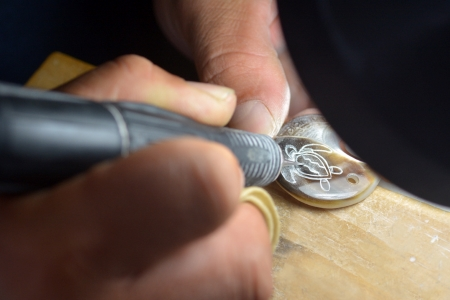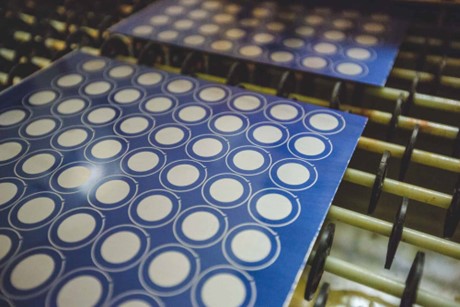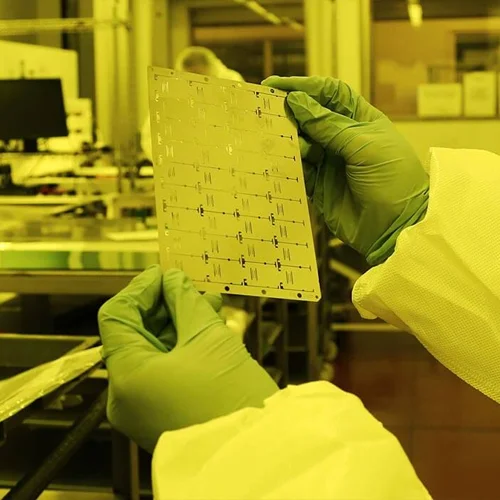Most people assume engraving and etching are the same thing, but they aren’t! Engraving is the physical removal of material with the use of tools or lasers. Etching, alternatively, is the use of a chemical to remove the top layer of the material. The differences between the two processes are significant. If you are working on manufacturing, personalizing products, or fine-tuning a design, the wrong choice may lead to wasted time and money. This guide will provide an overview of both methods, where each is applicable.

What is Engraving
Engraving is the process of removing material from a surface by cutting into it. It might be easier to understand by thinking about carving: a sharp tool or laser beam cuts down into a material. It leaves grooves or markings behind. Traditionally, artisans have used a sharp-tipped tool, called a burin (or graver), and push it along metal, wood, or the like, to do engraving.

Nowadays, we prefer to use rotary machines or lasers that vaporize the material with focused heat rays. Engraving creates depth that you can actually feel: simply run your finger along the engraved surface and you’ll notice the engraving immediately. It actually changes the structure of the material, layer by layer.
Advantages of Engraving
Engraving offers the following benefits:
- Deep cuts will resist fading for a much longer time.
- Metal, wood, plastic, glass, leather- as long as it is a solid object, you can probably engrave it. There is no wait time for chemicals to dry.
- Lasers can make clear, accurate marks that are even thousandths of an inch.
- We don’t have to deal with hazardous chemicals or disposal.
What is Etching
Etching uses chemicals to dissolve away material. Instead of cutting, you are selectively removing surface material in a controlled manner. This process begins with a protective covering called a resist to cover all areas of the substrate you want to keep protected. Next, the substrate is exposed to an acid bath or other chemical solution that will attack the substrate in areas that are not protected.

One of the advantages of etching is how it handles intricate detail. A single run through the etching process may produce hundreds of tiny features all at once, which would take forever to replicate by cutting.
Advantages of Etching
Here are some of the advantages of etching:
- Create intricate, detailed designs across a full surface all at once.
- Material remains the same because there is no use of physical force.
- Work with metals down to 0.01 mm without any warping of the material thickness.
- The chemical action will produce the same depth through all the features produced.
Applications of Etching
- Printed circuit boards (PCBs) for electronics.
- Precision components for aerospace.
- Medical implants and surgical tools.
- Decorative glassware and artistic metals.
- Sensors in the automotive world and plates for fuel cells.
- Industrial filters and mesh screens.
TMNetch Precision Etching
TMNetch merges engineering precision with large-scale photochemical etching capabilities. By holding ISO 9001: 2015 Certification and five automated production lines, TMNetch is capable of manufacturing burr-free and stress-free metal components with micron-level precision.

TMNetch offers:
- Etching accuracy down to ±0.03mm
- Compatibility with metals from 0.01mm to 3.0 mm
- Rapid prototyping in hours, not weeks
- Volume scalability without tool wear or distortion
Partner with TMNetch to turn ideas into manufacturable precision. Visit TMNetch to get started.
Engraved vs Etched: Key Differences
Let’s look at some differences between engraving and etching:
Process:
- Engraving: Engraving is a straightforward mechanical removal. A cutting tool (or laser) literally removes the material, cutting a V-shaped groove into the surface. You control the depth based on the depth of the cutting tool or the amount of the laser that vaporizes the material.
- Etching: Etching operates chemically. You will typically coat the material in a protective resist, expose your pattern, and let the acid (or etchant) dissolve the exposed area.
Applications
Choose engraving for:
- Deep, permanent marks that need to endure harsh conditions
- Fast production on individual pieces or small runs
- Multiple varied materials in one project
- Three-dimensional surface work
- Personalization work
Etching is used for:
- Intricate pattern work with complex features
- High volume production runs
- High volume production of fragile and ultra-thin materials that cannot withstand mechanical stress
- Electronics and PCB quality and performance specifications
- Projects that require burr-free edges
Precision and Details:
- Engraving: Engraving is great for bold, deep features. Newer modern laser systems are at the point of hitting tolerances around .001, which is great for text or defined shapes. The depth adds great contrast.
- Etching: Etching is better for intricate work. Photochemical processes can be created and controlled to have very little thickness.
Cost:
- Engraving: For small runs, engraving costs less up front. Laser systems quickly process individual pieces, with no setup fees. This works well if you are doing one-offs or for custom work where you are changing designs every time.
- Etching: Etching is the more economically favorable option when you are able to do higher volume, since the initial tooling and the initial setup are more expensive, but the price per piece drops significantly for larger production runs. With one chemical bath, you can simultaneously process dozens or even hundreds of parts.
Material Compatibility:
Engraving works on:
- Metals (all types)
- Plastics and acrylics
- Wood and composites
- Glass and ceramics
- Leather and some fabrics
- Stone and concrete
Etching works well on:
- Metals (must be chemically reactive)
- Glass
- Silicon wafers
- Some ceramics
Etching is more selective about material since everything is based on a chemical reaction. If the material does not react with your etchant, then it won’t work.
Which Method Is Better for Your Project?
Both processes have their advantages and disadvantages. The suitable process for you depends on the nature of your project and the desired outcomes.
- Durability: Both processes have durable, long-lasting marks. Engraved marks are permanent since they are made by cutting the material.
- Complexity: If the design features, such as fine lines, small letters, or intricate shapes, etching is likely your best option.
- Product Volume: If you are producing large volume production runs, etching is more time and resource-efficient.
- Material Flexibility: Engraving is compatible with a wide range of materials, including wood, plastic, glass, or leather.
- Customization: If you are working on unique or customized items, you will want to use engraving since it requires a fast setup time and no chemical preparation.
FAQs About Engraved vs Etched
Is the etched the same as engraved?
No. Engraving is a physical removal process of material using tools or lasers. etching uses acids to dissolve material chemically. Although both methods are capable of creating permanent designs, they produce designs using completely different processes, in completely different ways.
Which is better, etching or engraving?
There isn’t a better or worse method. Engraving is best for durable and varied material types. Etching is best for more complex patterns and situations where high volumes are of importance. The right method for your application will depend on project requirements, materials specifications, and production/cost volume.
Is etching cheaper than engraving?
It may depend on volume. Engraving may be less expensive for small batches, as set-up time is minimal. Etching becomes more affordable as the volume produced increases due to the chemical bath. It processes many parts of the same material at the same time.
What are the disadvantages of etching?
Etching requires handling and disposing of chemicals. Therefore, your material choices should be those that react to the chemical process. Individual pieces take longer to etch, and they create a lesser (shallower) mark than engraving. Also, etching is less suited for areas where wear is evident.
Conclusion
Choosing between engraving and etching is not about one process being better than another – it’s about choosing the right process to suit your needs. Engraving produces longevity and works on multiple materials; etching can work with more complicated designs and scales better. Think about your material, production quantity, details, and timelines. Knowing these differences helps you make the proper decision, save money, and determine the right process for your application. TMNetch uses the experience and capabilities of engineers to work for you on high-precision etching projects.
